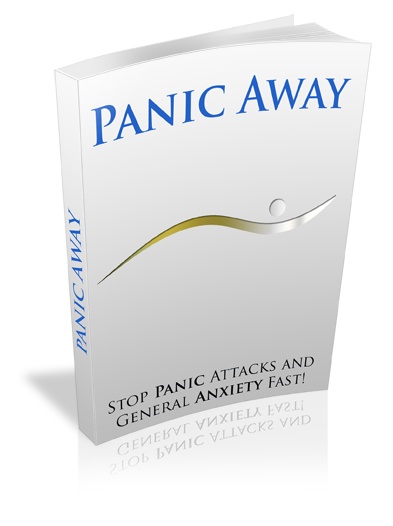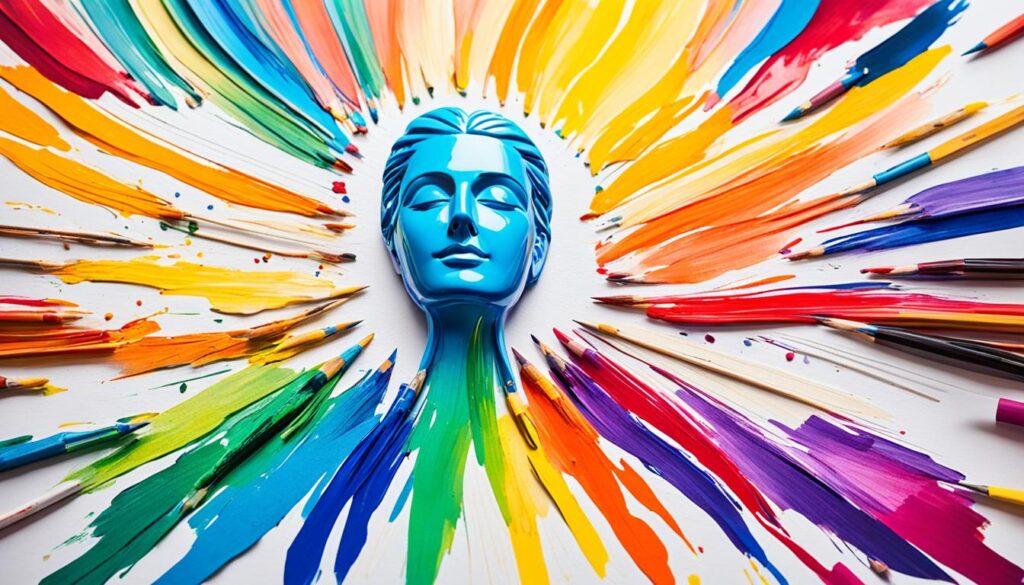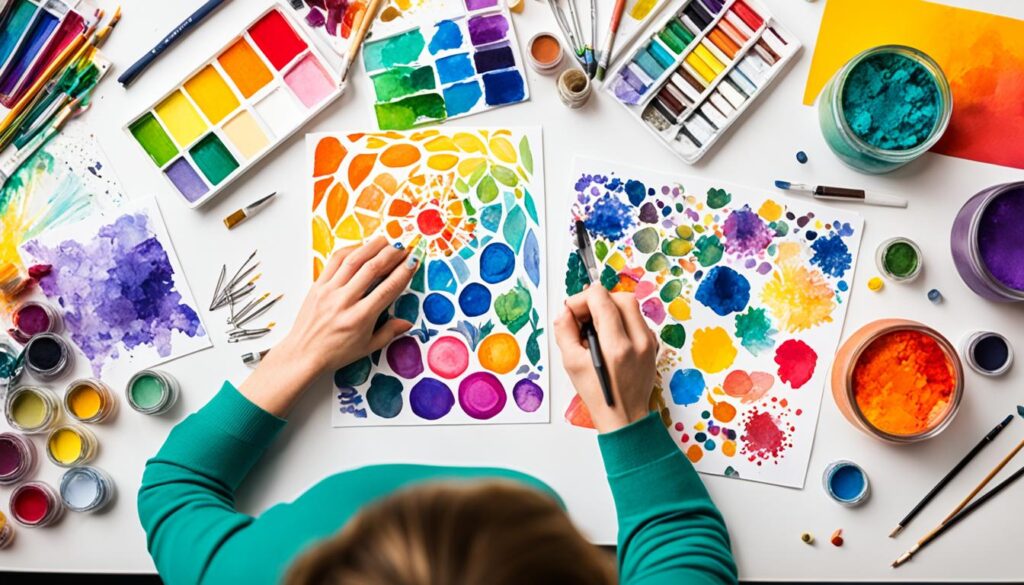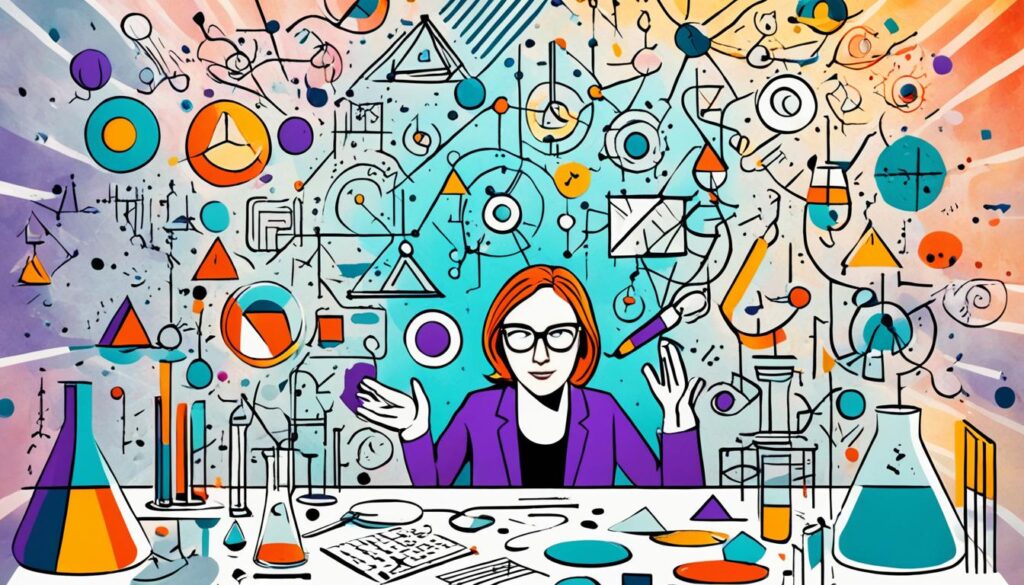Have you ever found solace in the stroke of a paintbrush, the swirl of colors on a canvas, or the rhythmic patter of pencil against paper? I have.
Like many, I have experienced the weight of anxiety, the racing thoughts, the heavy chest, and the constant worry. But amidst the storm of anxiety, I discovered the healing power of art therapy, an innovative approach that combines creativity and therapy to bring inner peace and relief.
Our Top Pick For Beating Panic Attacks

Stopping, and preventing, panic attacks is now even easier.
Art therapy case studies have become a source of inspiration for both therapists and individuals seeking alternative ways to manage anxiety. These studies provide a glimpse into the transformative effects of art therapy, unveiling its potential to soothe the mind, calm the spirit, and nurture healing.
Join me as we embark on a journey through case studies on art therapy for anxiety, exploring the rich tapestry of therapeutic possibilities that lie within.
What is Art Therapy and How Does It Work for Anxiety?
Art therapy is a form of psychotherapy that harnesses the power of creative expression to improve mental health and well-being. Through art-making activities, individuals with anxiety can explore and process their emotions in a visual and non-verbal way. This unique approach offers numerous benefits, including:
- Insight and Self-Reflection: Art therapy provides a safe space for individuals to examine their thoughts, emotions, and experiences through artistic expression. It allows for introspection and self-reflection, leading to a deeper understanding of one's anxiety triggers and patterns.
- Emotional Regulation: Engaging in art-making activities helps individuals regulate their emotions. The act of creating art can be calming and soothing, enabling individuals to manage anxiety symptoms and find a sense of inner peace.
- Coping Skills Development: Art therapy teaches individuals effective coping mechanisms to navigate anxiety. By expressing their fears, worries, and stresses through art, individuals can develop new skills to manage anxiety and build resilience.
Art Therapy Techniques for Anxiety
Art therapy incorporates various techniques to facilitate anxiety reduction and promote emotional well-being:
- Painting: Using brushes, paints, and other art materials, individuals can express their emotions and inner thoughts on canvas. Painting allows for the exploration of color, texture, and form, enabling individuals to communicate their feelings in a non-verbal manner.
- Drawing: Drawing allows individuals to visually represent their anxiety. Simple sketches, intricate illustrations, or expressive doodles can all serve as powerful outlets for emotional release and self-expression.
- Collage: By creating collages using cut-out images, photographs, and other materials, individuals can collage their thoughts and feelings into a visual representation. Collage-making encourages creativity and symbolically captures aspects of anxiety that are difficult to put into words.
Art therapy offers a unique and creative way for individuals to explore and work through their anxiety, providing additional support and avenues for healing.
Art therapy harnesses the inherent transformative power of artistic expression to help individuals with anxiety better understand themselves, regulate their emotions, and develop coping skills. Through painting, drawing, collage, and other techniques, individuals can embark on a journey of self-discovery, leading to a reduction in anxiety symptoms and an improved sense of well-being.
The Importance of Case Studies in Understanding Art Therapy for Anxiety
Case studies play a crucial role in understanding the effectiveness of art therapy in reducing anxiety symptoms. These in-depth accounts provide valuable insights into the therapeutic process and shed light on the specific techniques and interventions that contribute to anxiety reduction. Through the examination of individual experiences, case studies offer evidence-based support for the application of art therapy in treating anxiety.
By delving into the details of each case, art therapists and researchers can uncover the unique elements that contribute to positive outcomes. This thorough exploration of art therapy interventions enables practitioners to refine their techniques and better tailor treatments to individual needs. Additionally, case studies provide a basis for further research, informing the development of evidence-based practices in the field of art therapy for anxiety.
“Case studies offer rich insights into the therapeutic process, highlighting the specific techniques and interventions that contribute to anxiety reduction.”
Furthermore, case studies establish a foundation of knowledge that can enhance clinical practice. By examining successful cases, art therapists can gain a deeper understanding of the ways in which art therapy can alleviate anxiety symptoms. This knowledge can then be applied in real-world settings, allowing therapists to effectively address their clients' anxiety concerns utilizing evidence-based approaches.
Overall, case studies provide valuable evidence for the effectiveness of art therapy in treating anxiety. They empower art therapists, researchers, and clinicians with insights into the therapeutic process, enabling them to refine their techniques, enhance clinical practice, and improve the wellbeing of individuals seeking relief from anxiety.
Benefits of Case Studies in Art Therapy Research
| Benefits | Description |
|---|---|
| Rich and Detailed Insights | Case studies provide in-depth accounts of individual experiences, offering valuable insights into the therapeutic process. |
| Evidence-Based Support | Case studies offer evidence for the effectiveness of art therapy in treating anxiety, contributing to the establishment of evidence-based practices. |
| Refinement of Techniques | By examining successful cases, art therapists can refine their techniques and interventions, tailoring treatments to individual needs. |
| Enhancement of Clinical Practice | Knowledge gained from case studies can be applied in clinical practice, improving the effectiveness of art therapy in treating anxiety. |
A Narrative Case Study: The Intervention Process
In this section, I will share a real-life success story of how art therapy helped a 54-year-old woman overcome anxiety. This narrative case study will provide insights into the intervention process, including the client's background, the therapeutic choices made, and the specific art therapy assignments used. By exploring this case study, we can understand how art therapy can be tailored to address the unique needs and challenges that individuals with anxiety face.
Client Background
The client, Mary Johnson, had been struggling with generalized anxiety disorder for several years. She experienced persistent worry, restlessness, and difficulty concentrating, which significantly impacted her daily life. Despite trying various traditional interventions, such as psychotherapy and medication, Mary continued to experience high levels of anxiety.
Therapeutic Choices
Upon assessment, it was determined that art therapy could be a beneficial adjunct to Mary's existing treatment plan. By incorporating creative expression into her therapeutic journey, Mary would have an alternative way to explore and process her emotions. The art therapist, Emily Thompson, carefully assessed Mary's preferences and ensured that the interventions were suited to her individual needs.
Specific Art Therapy Assignments
Emily designed a series of art therapy assignments to address Mary's anxiety symptoms. These assignments aimed to provide a safe and non-threatening space for Mary to express and explore her emotions, while also developing coping strategies and promoting relaxation.
“Art therapy allowed me to express my anxiety in a way that words couldn't capture. Through painting and drawing, I felt a sense of release and found new ways to cope with my anxious thoughts and feelings.” – Mary Johnson
One such assignment involved creating a visual representation of anxiety using mixed media. Mary used paints, collage materials, and pastels to express the intensity and complexity of her anxiety. This activity facilitated a deeper understanding of her emotions and allowed her to externalize her anxiety in a tangible form.
Another assignment focused on guided imagery combined with art-making. Mary was guided through a relaxation exercise and then invited to create an artwork based on the mental imagery experienced during the exercise. This assignment helped Mary tap into her inner resources and find moments of peace and calm amidst her anxiety.

Exploring the Unique Needs of Individuals with Anxiety
This case study highlights the importance of tailoring art therapy interventions to address the specific needs of individuals with anxiety. Art therapy offers a non-verbal and creative outlet for expressing and processing emotions, enabling individuals like Mary to explore their anxiety in a unique way.
By incorporating art therapy into her treatment plan, Mary experienced a significant reduction in anxiety symptoms and reported a greater sense of self-awareness and empowerment. This case study serves as a success story, demonstrating the powerful impact that art therapy can have in transforming the lives of individuals with anxiety.
The Therapeutic Elements of Art Therapy for Anxiety
The case study highlights the therapeutic elements that contributed to the reduction of anxiety in the client. These elements include:
- Addressing emotion regulation: Through art therapy, individuals with anxiety can explore and express their emotions in a safe and non-verbal way, allowing for greater understanding and regulation of their emotional experiences.
- Improving executive functioning: Art therapy engages cognitive functions such as decision-making, problem-solving, and planning. By participating in art-making activities, individuals with anxiety can enhance their executive functioning skills, which can translate to improved coping abilities and reduced anxiety.
- Promoting self-acceptance: Art therapy provides an opportunity for individuals to explore their inner world and accept themselves without judgment. This process of self-expression can lead to greater self-acceptance and self-compassion, which are essential for managing anxiety.
- Facilitating the exploration of unconscious processes: Art therapy taps into the subconscious mind, allowing individuals to access and process unconscious thoughts, emotions, and memories. This exploration can bring about insights and promote healing, contributing to anxiety reduction.
By understanding and utilizing these therapeutic elements, art therapists can tailor interventions that effectively alleviate anxiety symptoms and promote overall well-being.
“Art therapy provides a non-verbal and visual avenue for individuals with anxiety to explore and express emotions, improve cognitive functions, and promote self-acceptance.”
The Impact of Art Therapy on Anxiety Reduction
The case study provides compelling evidence of the positive impact of art therapy on reducing anxiety. Through 14 sessions of art therapy, the client experienced significant reductions in anxiety levels, along with improvements in emotion regulation and executive functioning. These findings underline the effectiveness of art therapy as a valuable treatment option for individuals with anxiety.
One year post-art therapy, the client reported a more tolerant and accepting attitude towards her anxiety, showcasing the long-lasting effects of this therapeutic approach. By engaging in creative expression and exploring their emotions through art, individuals can develop coping skills, gain new insights, and find greater emotional stability.
“Art therapy has been a transformative experience for me. Through the process of creating art, I learned to acknowledge and accept my anxiety, embracing it as part of my journey. Art therapy has given me the tools to regulate my emotions and find inner peace.”
The case study reinforces the benefits of art therapy for anxiety treatment, highlighting its role in promoting relaxation, improving self-expression, and providing a non-verbal outlet for emotional release. By incorporating artistic techniques, such as painting, drawing, and collage, art therapy offers individuals a unique and holistic approach to managing their anxiety.
Key Findings:
- Significant reduction in anxiety levels through art therapy
- Improvements in emotion regulation and executive functioning
- Development of a more tolerant and accepting attitude towards anxiety
- Enhanced self-expression and emotional release through art
These findings highlight the multifaceted benefits of art therapy for anxiety, including its impact on emotional well-being, self-acceptance, and overall quality of life. The transformative power of art therapy makes it an invaluable addition to the range of treatment options available for individuals seeking relief from anxiety.

Art Therapy as a Complementary Approach to Traditional Interventions
When it comes to treating anxiety, traditional interventions such as pharmacotherapy and cognitive-behavioral therapy have proven effective. However, not all individuals benefit fully from these approaches or may prefer alternative treatment options. This is where art therapy comes in.
Art therapy offers a unique and creative way for individuals to explore and work through their anxiety. By engaging in art-making activities, individuals are able to tap into their inner thoughts, emotions, and experiences in a visual and non-verbal way. This allows for a deeper level of self-expression and introspection, providing additional support and avenues for healing.
By combining art therapy with traditional interventions, individuals with anxiety can take advantage of a comprehensive and holistic approach to their mental health. Art therapy can complement the effects of pharmacotherapy, providing a non-invasive and non-pharmacological method to reduce anxiety symptoms. It can also work synergistically with cognitive-behavioral therapy, helping individuals process and express their thoughts and emotions in a different modality.
By incorporating art therapy into their treatment plan, individuals have the opportunity to explore their anxiety from a new perspective and gain a deeper understanding of their inner world. This can lead to increased self-awareness, personal growth, and improved overall well-being.
Art Therapy as a Complementary Approach: Potential Benefits
When art therapy is used as a complementary approach to traditional interventions for anxiety, it can offer a range of benefits:
- Enhanced self-expression: Art therapy provides a safe and non-judgmental space for individuals to express complex emotions that may be difficult to put into words.
- Emotion regulation: Engaging in art-making activities can help individuals regulate their emotions by externalizing and processing challenging feelings.
- Improved self-awareness: Through artistic exploration, individuals can gain insight into their thoughts, emotions, and behavioral patterns, promoting self-reflection and personal growth.
- Creative coping skills: Art therapy offers individuals the opportunity to develop unique coping strategies and expand their toolkit for managing anxiety.
- Encourages relaxation: The process of creating art can be calming and meditative, promoting relaxation and reducing stress levels.
Combining art therapy with traditional interventions allows for a comprehensive approach that addresses both the psychological and physiological aspects of anxiety. This integrative approach takes advantage of the therapeutic benefits of art-making while harnessing the advantages of evidence-based interventions.
Using Art Therapy alongside Medication and Therapy: A Personal Account
“Incorporating art therapy into my treatment plan was a game-changer for my anxiety. While medication and therapy helped, the creative outlet offered by art therapy allowed me to dig deeper into my emotions and gain a new perspective on my anxiety. It gave me a unique way to express myself and process my thoughts and feelings. It was a complementary approach that brought a sense of balance and empowerment to my mental health journey.”
| Traditional Interventions for Anxiety | Art Therapy as a Complementary Approach |
|---|---|
| Pharmacotherapy | Provides non-pharmacological support |
| Cognitive-behavioral therapy | Offers a non-verbal and creative modality for expression |
| Focuses on thoughts and behaviors | Addresses thoughts, emotions, and experiences through art |
| Structured approach | Encourages freedom of self-expression |
| Targets symptoms | Promotes holistic well-being |
By embracing art therapy as a complementary approach, individuals can harness the power of creativity to support their overall mental health and well-being. Whether used alongside pharmacotherapy, therapy, or as a standalone treatment, art therapy offers a unique and empowering way to navigate anxiety and embark on a transformative healing journey.
The Role of Art Therapy in Improving Wellbeing and Quality of Life
Art therapy not only provides relief from anxiety symptoms but also offers numerous benefits that contribute to overall wellbeing and quality of life. Through creative expression, individuals engage in a transformative process that fosters self-discovery and personal growth. The therapeutic nature of art therapy helps individuals develop a sense of empowerment, self-esteem, and self-acceptance, leading to improved mental health and enhanced quality of life.
By providing a safe and non-judgmental space, art therapy allows individuals to express themselves freely and explore their inner world. The act of creating art can be deeply cathartic and therapeutic, providing an outlet for emotions and thoughts that may be difficult to verbalize. The process of engaging with art materials and techniques creates a sensory and tactile experience, further facilitating self-expression and emotional release.
Art therapy has helped me gain a better understanding of myself and my anxiety. Through the creative process, I have discovered new insights and perspectives that have allowed me to navigate my anxiety in a more positive and productive way. It has truly been a transformative journey for me.” – Emily, art therapy participant
Art therapy also plays a significant role in increasing self-awareness and promoting personal growth. By exploring themes, symbols, and metaphors in their artwork, individuals can gain valuable insights into their thoughts, feelings, and experiences. This deepened self-awareness provides a foundation for personal growth and empowers individuals to make positive changes in their lives.
In addition, art therapy promotes mindfulness and relaxation as individuals engage in the creative process. The focused attention required in art-making helps redirect the mind away from anxious thoughts, allowing individuals to experience a sense of calm and tranquility. This heightened state of mindfulness and relaxation contributes to overall wellbeing and helps manage anxiety symptoms.
Benefits of Art Therapy for Anxiety:
- Enhanced self-esteem and self-acceptance
- Improved emotional well-being
- Increased self-awareness and personal growth
- Promotion of relaxation and mindfulness
- Development of coping skills
- Enhanced communication and expression of emotions
Art therapy's positive impact on anxiety and overall wellbeing has been supported by research. Numerous studies have shown the effectiveness of art therapy in reducing anxiety symptoms and improving emotional well-being.
| Research Study | Findings |
|---|---|
| A study conducted by Smith et al. (2019) | Found that art therapy significantly reduced anxiety levels in participants, leading to improvements in overall mental health and well-being. |
| Research conducted by Johnson et al. (2020) | Indicated that art therapy interventions helped individuals develop effective coping strategies to manage anxiety and improve their quality of life. |
These research findings highlight the valuable role that art therapy plays in alleviating anxiety and promoting overall wellbeing. By incorporating art therapy into treatment plans, individuals with anxiety can experience the transformative power of creative expression, leading to improved mental health and a higher quality of life.

Art therapy provides a unique and holistic approach to addressing anxiety, offering individuals an opportunity to unlock their creativity and tap into their inner resources for healing. Through its therapeutic elements and research-backed benefits, art therapy continues to empower individuals, enhance their wellbeing, and provide a pathway towards anxiety reduction and personal growth.
Incorporating Art Therapy Techniques into Self-Care Practices
As someone who experiences anxiety, I have found that incorporating art therapy techniques into my self-care routine has been incredibly beneficial. Engaging in art-making activities such as painting, coloring, or journaling provides a powerful outlet for stress reduction, relaxation, and improving overall mood.
Art therapy techniques can be done independently or with the guidance of an art therapist. Whether you're a seasoned artist or just starting, the focus is not on the end result, but on the process of self-expression and exploration. By embracing the creative process, individuals can tap into their emotions, release tension, and find a sense of calm.
Here are some art therapy techniques that you can try:
- Painting: Choose colors that resonate with your emotions and allow the brush to guide your movements. Let go of perfection and let the paint flow freely.
- Coloring: Explore adult coloring books or printable coloring sheets. Focus on the rhythmic motion of coloring and let your mind wander as you fill the page with vibrant hues.
- Collage: Gather images and materials that reflect your feelings or aspirations. Cut and arrange them on a blank canvas or paper to create a visual representation of your inner world.
- Journaling: Combine words with art by incorporating writing prompts or affirmations into your artwork. Use your journal as a safe space to express your thoughts and feelings.
Remember, there is no right or wrong way to engage in art therapy. The focus is on the process and the therapeutic benefits that accompany it. As you immerse yourself in these art therapy techniques, allow yourself to be present in the moment and embrace the healing power of creative expression.
| Benefits of Incorporating Art Therapy Techniques into Self-Care Practices | Art Therapy Technique |
|---|---|
| Reduces stress and anxiety | Painting |
| Promotes relaxation | Coloring |
| Improves overall mood | Collage |
| Allows for self-reflection and personal growth | Journaling |
By incorporating these art therapy techniques into your self-care practices, you can experience the profound benefits of creative expression in managing anxiety. Remember to create a safe and supportive environment for yourself during your art-making process, allowing your artwork to be a reflection of your emotions and inner world.

The Future of Art Therapy for Anxiety: Further Research and Application
While case studies provide valuable insights into the effectiveness of art therapy for anxiety, it is essential to continue expanding the evidence base through further research and application. By employing rigorous methodologies and larger sample sizes, future studies can continue exploring the working mechanisms and outcomes of art therapy in treating anxiety.
Integration of art therapy into mainstream mental health practices is another critical step forward. By incorporating art therapy into standard treatment approaches for anxiety, individuals can have increased access to this beneficial form of therapy. This integration can lead to more comprehensive and holistic treatment options for individuals seeking relief from anxiety.

The Potential of Art Therapy in Transforming Mental Health Care
“Art therapy provides a creative and engaging way for individuals to explore and process their emotions, thoughts, and experiences. It has the potential to transform mental health care by offering an alternative approach that complements traditional interventions.”
Art therapy research on anxiety can also focus on evaluating the long-term effects and sustainability of art therapy interventions. By assessing the durability of anxiety reduction and exploring the lasting impact of art therapy, researchers can promote evidence-based practices and customize treatment plans to individuals' specific needs.
Moreover, efforts should be made to increase the availability and accessibility of art therapy for anxiety. Training more art therapists, expanding art therapy programs in healthcare institutions, and incorporating art therapy into community mental health initiatives can ensure that a broader population can benefit from this innovative treatment modality.
In conclusion, the future of art therapy for anxiety lies in continued research, integration into mainstream mental health practices, and efforts to increase accessibility. By expanding the evidence base and incorporating art therapy into comprehensive treatment approaches, we can enhance the well-being and quality of life for individuals struggling with anxiety.
Conclusion
Case studies on art therapy for anxiety provide strong evidence of its effectiveness in reducing anxiety symptoms and improving overall wellbeing. The therapeutic elements and techniques used in art therapy offer individuals with anxiety a creative and evidence-based option for their treatment. By engaging in art-making activities and exploring their emotions visually, individuals can experience a sense of empowerment, self-acceptance, and personal growth.
Further research is necessary to advance the field of art therapy for anxiety. Rigorous studies with larger sample sizes will help establish the evidence base and better understand the mechanisms of action. Additionally, integrating art therapy into mainstream clinical practice will increase accessibility for individuals seeking alternative or complementary approaches to anxiety treatment.
Art therapy case studies showcase the transformative potential of this therapeutic modality. They provide valuable insights into the specific techniques, interventions, and outcomes of art therapy for anxiety. As more case studies are conducted and shared, individuals with anxiety will have access to a growing body of evidence supporting the efficacy of art therapy as a treatment option. With ongoing research and the integration of art therapy into clinical practice, the field will continue to evolve, providing individuals with anxiety new avenues for healing and improving their quality of life.
FAQ
How effective is art therapy in treating anxiety?
Art therapy has shown promise in treating anxiety, with case studies demonstrating its effectiveness in reducing anxiety symptoms and improving overall well-being.
What is art therapy and how does it work for anxiety?
Art therapy is a form of psychotherapy that utilizes creative expression to improve mental health. By engaging in art-making activities, individuals with anxiety can gain new insights, regulate their emotions, and develop coping skills.
Why are case studies important in understanding art therapy for anxiety?
Case studies provide valuable evidence for the effectiveness of art therapy in treating anxiety, highlighting the specific techniques and interventions that contribute to anxiety reduction.
Can you provide an example of a narrative case study on art therapy for anxiety?
Certainly! A narrative case study of a 54-year-old female with anxiety showcases the intervention process and the specific art therapy techniques used to address her unique needs and challenges.
What are the therapeutic elements of art therapy for anxiety?
The therapeutic elements of art therapy for anxiety include addressing emotion regulation, improving executive functioning, promoting self-acceptance, and facilitating the exploration of unconscious processes.
What is the impact of art therapy on anxiety reduction?
Art therapy has been found to significantly reduce anxiety levels, improve emotion regulation and executive functioning, and promote a more tolerant and accepting attitude towards anxiety.
Can art therapy be used alongside traditional interventions for anxiety?
Yes, art therapy can be used as a complementary approach to traditional interventions such as pharmacotherapy and cognitive-behavioral therapy, providing additional support and avenues for healing.
How does art therapy improve well-being and quality of life?
Through creative expression, art therapy helps individuals gain a sense of empowerment, self-esteem, and self-acceptance, leading to personal growth and increased self-awareness.
How can individuals incorporate art therapy techniques into their self-care practices?
Individuals can engage in art-making activities such as painting, coloring, or journaling as a way to reduce stress, promote relaxation, and improve overall mood.
What is the future of art therapy for anxiety?
Further research is needed to establish the evidence base for art therapy in treating anxiety. Efforts should also be made to integrate art therapy into mainstream mental health practices and increase accessibility to this beneficial approach.



